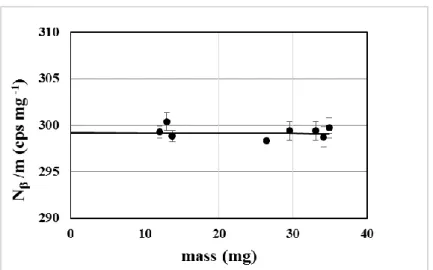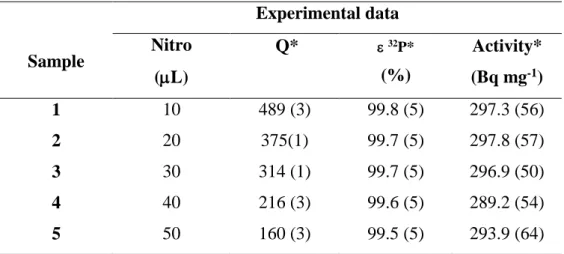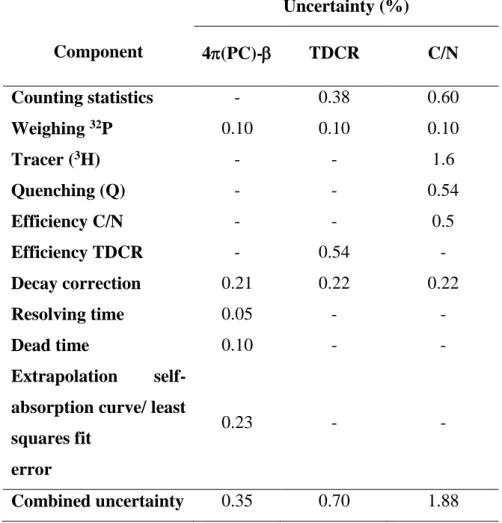BJRS
RADIATION SCIENCES
05-03-A (2017) 01-11Standardization of
32P radioactive solution
C. P. Marques
a; M. F. Koskinas
a; J. S. Almeida
a; I. M. Yamazaki
a; M. S. Dias
aaInstituto de Pesquisas Energéticas e Nucleares/ Centro do Reator de Pesquisas, São Paulo, SP, Brasil cpmarques@usp.br
ABSTRACT
The standardization solution using three different methods is presented. The disintegration rate was determined by the CIEMAT/NIST and TDCR methods in liquid scintillator systems and self-absorption extrapolation method using 4(PC)- system. The results obtained for the activity of the 32P solution were compared and they agree within
experi-mental uncertainties.
1. INTRODUCTION
The Nuclear Metrology Laboratory (LMN) at the IPEN, São Paulo, Brazil, has developed different methods for the standardization of pure beta emitter radionuclides such as 90Y, 35S, 14C [1-3] by
means of liquid scintillators systems and 4(PC)-coincidence systems in order to establish stand-ard methodologies. In this paper, the procedures applied to standstand-ardize a 32P radioactive solution are shown. For this standardization, two liquid scintillator systems and a 4(PC)- system were used. The radionuclide 32P may be produced in nuclear reactors mainly by 32S(n, p)32P and 31P(n,)32P reactions. The former reaction gives rise to 33P or 35S impurities and must be checked by analyzing the liquid scintillator beta spectra. One of the most important applications relies on its use in nuclear medicine for treatment of polycythemia vera, leukemia for distinct subgroup of elderly patients and treatments of skin [4]. The 32P has a half-life of 14.284 (36) days and decays by beta particles with endpoint energy of 1710.66 keV to 32S [5]. The 32P decay scheme is shown in figure 1.
Figure 1: 32P decay scheme
Source: reference [5]
The measurements in Liquid Scintillation Counting (LSC) systems were carried out in two systems. The first one was a TRICARB 2100 Packard system using the CIEMAT/NIST method [6], where a
laborato-ries around the world. The other was HIDEX 300SL system using the TDCR (Triple to Double Co-incidence Ratio) method [7].
The disintegration rate was also determined in a PC) system by applying the self-absorption extrapolation method [8]. A Time Amplitude Converter (TAC) method [9] was used to register the beta events detected in the proportional counter.
2. METHODS
2.1. CIEMAT/NIST Method
The CIEMAT/NIST method consists of relating the experimental efficiency of a standard 3H solu-tion, obtained from samples with different quenching, with the theoretical 3H efficiency, which is obtained in function of Factor of Merit (FM). This results in a relationship between quenching and Factor of Merit, which is called universal curve. By means of this curve, it is possible to determine the theoretical efficiency as a function of FM for the radionuclide under study, related to the corre-sponding experimental quenching. Code CN2001 [10] was used to obtain 3H and 32P theoretical efficiencies.
2.2. TDCR Method
TDCR method [7] uses three photomultipliers tubes (PMT) positioned at relative angle of 120 de-grees (A, B and C) and operated in coincidence. Through a special electronic system, the coinci-dence of the three PMT pairs, which are NAB, NAC, NBC, and ND and NT, the logical double and
tri-ple coincidence rates are collected. The arithmetic relationships among these rates [7,11] are given by:
𝑵𝑨𝑩+ 𝑵𝑩𝑪+ 𝑵𝑨𝑪 = 𝟐𝑵𝑻+ 𝑵𝑫 (1)
𝑵𝑻 = 𝑵𝑨𝑩𝑪 (2)
double coincidence count rates for the photomultipliers A and B; NAC is the double coincidence
count rates for the photomultipliers A and C and NBC is the double coincidence count rates for the
photomultipliers B and C. The double and triple counting rates are given by:
𝑵𝑫 = 𝑵𝟎𝜺𝑫 (3)
𝑵𝑻 = 𝑵𝟎𝜺𝑻 (4)
where D and Tare the double and triple counting efficiencies, respectively, and N0 is the activity.
For a large number of detected events, the ratio of NT/NDconverges to the ratio T/Dgiven by [12]:
𝑵𝑻⁄𝑵𝑫= 𝜺𝑻𝑫𝑪𝑹 (5)
The HIDEX 300SL system assumes that, for beta pure emitters, the TDCR = D [12] and the activity
is obtained by:
𝑵𝟎 = 𝑵𝑫/𝜺𝑻𝑫𝑪𝑹 (6)
2.3. Self-Absorption Method
The self-absorption method consists of measuring solid sources of the beta pure emitter, prepared in Collodion subtracts, with various aliquots of the solution, in a PC)system. From these meas-urements, a curve is obtained between Ncounting rate (cps mg-1) vs. sources mass (mg) which,
extrapolated to mass zero, gives the disintegration rate. A straight line using covariance methodolo-gy fits this curve. The intercept of this line yields the activity N0.
2.4. Experimental Set Up
2.4.1. Tricarb 2100 Liquid Scintillator Counting System
TRICARB Mod 2100 TR is a liquid scintillator counting system which detects the photons emitted from the scintillation vial by means of two photomultipliers tubes operated in coincidence. For this
measurement, the CIEMAT/NIST method was applied. Owing to it is necessary determine the quenching indicator parameter that was obtained by means of the tSIE (transformed Spectral Index of External Standard), which is calculated from the Compton spectrum induced in the scintillation cocktail, by an external source of 133Ba, placed near the measurement system [13].
2.4.2. HIDEX 300SL Liquid Scintillator Counting System
HIDEX 300SL is a commercial liquid scintillator counting system that uses the TDCR method. The HIDEX software, associated to the system, provides the TDCR efficiency and the activity in disin-tegration per minute (dpm). This system does not require samples with different quenching values.
2.4.3. 4(PC)- system
The 4(PC)- system used was a 4 proportional counter filled with P-10 gas (90% Argon plus 10% methane) operated at 0.1 MPa. The measurements in the proportional counter were performed in the integral mode, using a single channel analyzer (SCA) to discriminate the electronic noise. The events detected in the proportional counter were registered by a method developed by the LMN, which makes use of a Time Amplitude Converter (TAC), associated with a Multichannel Analyzer. In this method, after to be selected in the SCA, the detector pulses are sent to two gates and delay generators that will give the start and stop information to the TAC. The observed count-ing rate N was corrected for background, dead time and decay in the usual way.
2.4.4. Source preparation
The sodium phosphate (32P) solution was obtained from the Radiopharmaceutical Center (CR) at
IPEN. The radioactive solution was diluted in distilled water. No impurities were detected by liquid scintillation measurements. The sources, to be measured in the proportional counter, were prepared by dropping aliquots with different masses of the solution on a 20 g cm-2 thick Collodion film. This film has been previously coated with a 10 g cm-2 gold layer, in order to make the film
con-ductive. A seeding agent (CYASTAT SM) was used to improve the deposit uniformity and the sources were dried under a nitrogen jet at 45°C. A total of eight sources were prepared with masses ranging from 11 to 35 mg.
The samples for liquid scintillator were prepared by pouring 15 mL of Ultima Gold scintillator cocktail, by means a calibrated pipette, and 1 mL of distilled water, in polyethylene 20 mL vials. For the present measurements, five samples of 3H and 32P were prepared. After dropping the
radio-active solution into the scintillator cocktail, the samples were mixed and stirred to obtain a homoge-neous solution. Different amounts of nitro-methane solution were added in five samples in order to obtain different quenching factors and therefore different efficiencies. One extra sample with liquid scintillator plus water (blank) was prepared to measure the background.
The masses of radioactive material determination were performed using the pycnometer technique [14] in a Mettler balance model XP56. Buoyancy correction has been applied to all masses.
3. RESULTS AND DISCUSSION
The self-absorption extrapolation curve obtained with 4π(PC)- system is presented in figure 2. The fit of a straight line was performed by least squares by means of code LINFIT [15], which incorpo-rates covariance matrix methodology.
Figure 2: Self-absorption extrapolation curve of 32P 4π(PC)- system. The black marks correspond
Table 1 presents the sample mass, TDCR efficiencies and 32P activity results with total uncertainties obtained using the HIDEX 300SL liquid scintillator system.
Table 1: Activity results obtained with TDCR method in HIDEX 300SL system. Experimental data Sample Mass (mg) TDCR* (%) Activity* (Bq mg-1) 1 17.026 99.7 (4) 300.8 (16) 2 9.147 99.6 (5) 301.6 (21) 3 11.224 99.5 (5) 301.1 (19) 4 8.119 99.3 (6) 294.8 (22) 5 8.627 99.1 (6) 299.4 (22)
*Absolute uncertainty is given in parentheses
In table 2, the amount of carrier, the quenching parameter (tSIE), 32P efficiencies and the activity obtained by the application of CIEMAT/NIST method are shown.
Table 2: Activity results obtained with CIEMA/NIST method in TRICARB 2100 system. Experimental data Sample Nitro (L) Q* 32P* (%) Activity* (Bq mg-1) 1 10 489 (3) 99.8 (5) 297.3 (56) 2 20 375(1) 99.7 (5) 297.8 (57) 3 30 314 (1) 99.7 (5) 296.9 (50) 4 40 216 (3) 99.6 (5) 289.2 (54) 5 50 160 (3) 99.5 (5) 293.9 (64)
*Absolute uncertainty is given in parentheses
uncertainties involved were: fitting procedure, counting statistics from Nβ and beta background,
which were considered uncorrelated, and the uncertainties in weighing, dead time, decay correction and resolving time, considered correlated. The uncertainty due to count statistics is included in the extrapolation curve fitting.
For the TDCR method, the uncorrelated uncertainties considered were counting statistics, TDCR efficiency and background; the uncertainties in weighing and decay correction were considered cor-related. For the CIEMAT/NIST method, the counting statistic and quenching parameter were con-sidered uncorrelated and the 3H and 32P efficiencies, weighing and decay correction were consid-ered correlated
Table 3: Typical partial uncertainties in the activities for the three methods, in percent (k=1). Uncertainty (%) Component 4(PC)- TDCR C/N Counting statistics - 0.38 0.60 Weighing 32P 0.10 0.10 0.10 Tracer (3H) - - 1.6 Quenching (Q) - - 0.54 Efficiency C/N - - 0.5 Efficiency TDCR - 0.54 - Decay correction 0.21 0.22 0.22 Resolving time 0.05 - - Dead time 0.10 - - Extrapolation self-absorption curve/ least squares fit
error
0.23 - -
Combined uncertainty 0.35 0.70 1.88
(299.9 ± 1.2) Bq mg-1, with the 4(PC)-system, (299.8 ± 1.5) Bq mg-1, with TDCR method and
(296.0 ± 4.7) Bq mg-1, with CIEMAT/NIST method, respectively. As can be seen, the final values
obtained with the three methods agree within the experimental uncertainties.
4. CONCLUSION
Absolute activity measurements of 32P were carried out by means of three distinct methods and the results obtained from these methods agree within the experimental uncertainties, confirming their feasibility.
However, the TDCR method proved being more convenient for 32P standardization compared with the method of self-absorption due to sample preparation and it is more convenient than CIE-MAT/NIST method because it does not require neither the use of a standard solution as tracer, nor the use of quenching agents.
5. ACKNOWLEDGMENT
The authors are indebted to the National Council for Scientific and Technological Development (CNPq), from Brazil, for partial support to the present research work.
REFERENCES
1. NASCIMENTO, T. S.; KOSKINAS, M. F.; MATOS, I. T.; YAMAZAKI, I. M.; RAJPUT, M. U.; DIAS, M.S. Standardization of Y-90 by tracing method, In: INTERNATIONAL
NUCLEAR ATLANTIC CONFERENCE, 2013, Recife.
2. KOSKINAS, M. F.; LITVAK, F.; BRITO, A. B.; DIAS, M.S. Standardization of 35S radio-active solution in liquid scintillation counting system by means of the CIEMAT /NIST method compared with 4πβ−γ tracing method, In: INTERNATIONAL NUCLEAR
3. KOSKINAS, M. F.; KUZNETSOVA M.; I. T., YAMAZAKI, I. M.; BRANCACCIO F.; DIAS, M.S. Standardization of 14C by tracing method, In: INTERNATIONAL NUCLEAR
ATLANTIC CONFERENCE, 2015, São Paulo.
4. NAJEAN, Y.; RAIN, J.D. Treatment of polycythemia vera: use of 32P alone or in combina-tion with maintenance therapy using hydroxyurea in 461 patients greater than 65 years of age. Blood, v.89, p. 2319–2327, 1997.
5. CHRISTÉ, V; BÉ, M. M. Laboratoire National Henri Becquerel. Paris, France. 2004. Available at: < http:// www.nucleide.org/DDEP_WG/Nuclides/P-32_tables.pdf >. Last ac-cessed: 31 May, 2017.
6. GRAU MALONDA, A.; GARCIA-TORAÑO E. Evaluation of counting efficiency in liquid scintillation counting of pure -ray emitters. Int. J. Appl. Radiat. Isotopes, v.33, 249-253, 1982.
7. BRODA, R.; CASSETTE, P.; KOSSERT, K. Radionuclide metrology using liquid scintilla-tion counting. Metrologia, v.44, S36-S52, 2007.
8. DA CRUZ, P. A. L.; IWAHARA, A.; BERNARDES, E. M.O.; DA SILVA, C. J. The abso-lute standardization of 32P and 204Tl at LNMRI. Applied Radiation and Isotopes, v.60, 415–418, 2004.
9. KOSKINAS, M. F.; SILVA, E. A.; YAMAZAKI, I. M.; DIAS, M.S. Standardization of
241Am solution. Applied Radiation and Isotopes, v.64, 1238–1241, 2006.
10. Günther E., CN2001A Code. 2001. PTB 6.11, Bundesallee 100, D-38 116 Braunschweig, Germany.
11. KOSSERT, K.; BRODA R.; CASSETTE P.; RATEL G.; ZIMMERMAN, B. Uncertainty determination for activity measurements by means of the TDCR method and the CIE-MAT/NIST efficiency tracing technique. Metrologia, v.52, S172–S190, 2015.
12. WANKE, C.; KOSSERT, K.; NAHLE, O. J. Investigations on TDCR measurements with the HIDEX 300 SL using a free parameter model. Applied Radiation and Isotopes, v.70, 2176–2183, 2012.
13. THOMSON, J. Use and preparation of quenching curves in liquid scintillation counting. Liquid scintillation counting application. Note LSC-007 Packard Bio Science, 2001.
14. BIPM – Bureau International des Poids et Mesures. CAMPION, P.J. Procedures for
ac-curately diluting and dispensing radioactive solutions. Paris: BIPM, 1975. 1 – 32p.
15. DIAS, M.S. LINFIT: a code for linear least square fit with covariance analysis. Internal



